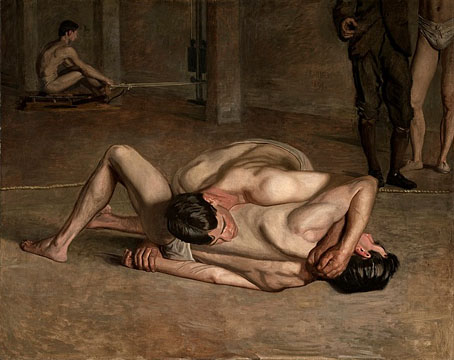The Wrestlers.
Born in Philadelphia, Eakins studied at the Pennsylvania Academy of Fine Arts, where he would later teach, from 1862, before travelling to Paris where he enrolled at the École des Beaux-Arts. His final six months in Europe were spent in Spain. Returning to Philadelphia in July 1870, he set himself up as a portrait painter with financial support from his father.
Eakins’ study of anatomy extended to the study of human movement and in 1884 he assisted the photographer Muybridge in his studies of human and animal locomotion. Eakins himself was a keen photographer and produced a number of photographic studies of the figure in motion.
Many of his paintings depict the athletic male body in action. The importance of the male figure for Eakins is particularly evident in the many photographs that he took throughout the 1880s of himself and his (mostly male) students posing nude either in the studio or else engaged in various outdoor sporting activities.
Nudity both inside the studio and beyond was intrinsic to Eakins’ aim of fostering camaraderie amongst his students, as he sought to recreate within his circle the ethos and practices of an ancient Greek Academy.
The painting The Swimming Hole (c. 1884), which was based upon photographs taken by Eakins and depicts a group of seven nude men comprised of Eakins and his students, can be viewed as a contemporary rendering of a classical Arcadian theme.
Following a dispute between Eakins and the Pennsylvania Academy of Fine Arts over students admissions, the Board of Directors forced him to resign in 1886 – ostensibly over a claim that he had removed the loincloth from a male model in a mixed life drawing class.
Eakins died in Philadelphia, his growing reputation as a key figure in American realist painting secured by exhibitions held in New York and Philadelphia. After his death, a number of his negatives of nude men were destroyed.
Elsewhere on { feuilleton }
• The gay artists archive



I admire people who in XIX and beginings of XX century painted such subjects. They were not good times for such artists.